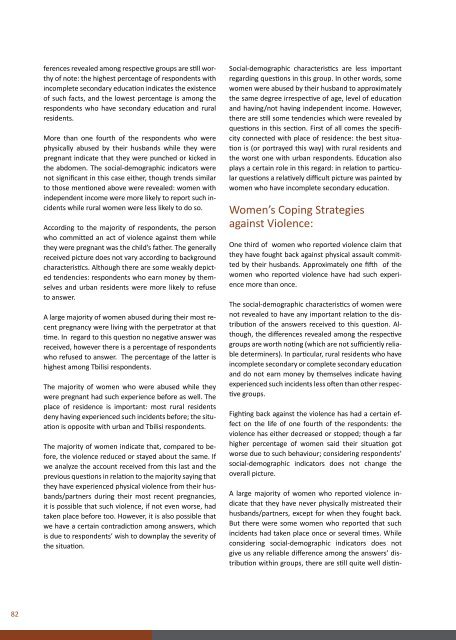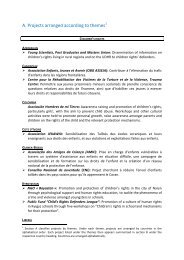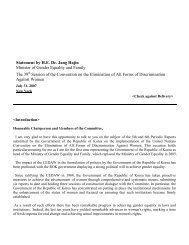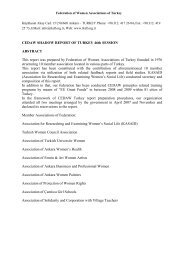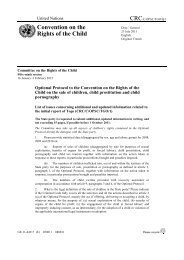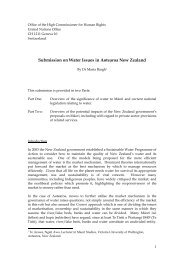National Research on Domestic Violence Against Women in
National Research on Domestic Violence Against Women in
National Research on Domestic Violence Against Women in
You also want an ePaper? Increase the reach of your titles
YUMPU automatically turns print PDFs into web optimized ePapers that Google loves.
ferences revealed am<strong>on</strong>g respective groups are still worthyof note: the highest percentage of resp<strong>on</strong>dents with<strong>in</strong>complete sec<strong>on</strong>dary educati<strong>on</strong> <strong>in</strong>dicates the existenceof such facts, and the lowest percentage is am<strong>on</strong>g theresp<strong>on</strong>dents who have sec<strong>on</strong>dary educati<strong>on</strong> and ruralresidents.More than <strong>on</strong>e fourth of the resp<strong>on</strong>dents who werephysically abused by their husbands while they werepregnant <strong>in</strong>dicate that they were punched or kicked <strong>in</strong>the abdomen. The social-demographic <strong>in</strong>dicators werenot significant <strong>in</strong> this case either, though trends similarto those menti<strong>on</strong>ed above were revealed: women with<strong>in</strong>dependent <strong>in</strong>come were more likely to report such <strong>in</strong>cidentswhile rural women were less likely to do so.Accord<strong>in</strong>g to the majority of resp<strong>on</strong>dents, the pers<strong>on</strong>who committed an act of violence aga<strong>in</strong>st them whilethey were pregnant was the child’s father. The generallyreceived picture does not vary accord<strong>in</strong>g to backgroundcharacteristics. Although there are some weakly depictedtendencies: resp<strong>on</strong>dents who earn m<strong>on</strong>ey by themselvesand urban residents were more likely to refuseto answer.A large majority of women abused dur<strong>in</strong>g their most recentpregnancy were liv<strong>in</strong>g with the perpetrator at thattime. In regard to this questi<strong>on</strong> no negative answer wasreceived, however there is a percentage of resp<strong>on</strong>dentswho refused to answer. The percentage of the latter ishighest am<strong>on</strong>g Tbilisi resp<strong>on</strong>dents.The majority of women who were abused while theywere pregnant had such experience before as well. Theplace of residence is important: most rural residentsdeny hav<strong>in</strong>g experienced such <strong>in</strong>cidents before; the situati<strong>on</strong>is opposite with urban and Tbilisi resp<strong>on</strong>dents.The majority of women <strong>in</strong>dicate that, compared to before,the violence reduced or stayed about the same. Ifwe analyze the account received from this last and theprevious questi<strong>on</strong>s <strong>in</strong> relati<strong>on</strong> to the majority say<strong>in</strong>g thatthey have experienced physical violence from their husbands/partnersdur<strong>in</strong>g their most recent pregnancies,it is possible that such violence, if not even worse, hadtaken place before too. However, it is also possible thatwe have a certa<strong>in</strong> c<strong>on</strong>tradicti<strong>on</strong> am<strong>on</strong>g answers, whichis due to resp<strong>on</strong>dents’ wish to downplay the severity ofthe situati<strong>on</strong>.Social-demographic characteristics are less importantregard<strong>in</strong>g questi<strong>on</strong>s <strong>in</strong> this group. In other words, somewomen were abused by their husband to approximatelythe same degree irrespective of age, level of educati<strong>on</strong>and hav<strong>in</strong>g/not hav<strong>in</strong>g <strong>in</strong>dependent <strong>in</strong>come. However,there are still some tendencies which were revealed byquesti<strong>on</strong>s <strong>in</strong> this secti<strong>on</strong>. First of all comes the specificityc<strong>on</strong>nected with place of residence: the best situati<strong>on</strong>is (or portrayed this way) with rural residents andthe worst <strong>on</strong>e with urban resp<strong>on</strong>dents. Educati<strong>on</strong> alsoplays a certa<strong>in</strong> role <strong>in</strong> this regard: <strong>in</strong> relati<strong>on</strong> to particularquesti<strong>on</strong>s a relatively difficult picture was pa<strong>in</strong>ted bywomen who have <strong>in</strong>complete sec<strong>on</strong>dary educati<strong>on</strong>.<strong>Women</strong>’s Cop<strong>in</strong>g Strategiesaga<strong>in</strong>st <strong>Violence</strong>:One third of women who reported violence claim thatthey have fought back aga<strong>in</strong>st physical assault committedby their husbands. Approximately <strong>on</strong>e fifth of thewomen who reported violence have had such experiencemore than <strong>on</strong>ce.The social-demographic characteristics of women werenot revealed to have any important relati<strong>on</strong> to the distributi<strong>on</strong>of the answers received to this questi<strong>on</strong>. Although,the differences revealed am<strong>on</strong>g the respectivegroups are worth not<strong>in</strong>g (which are not sufficiently reliabledeterm<strong>in</strong>ers). In particular, rural residents who have<strong>in</strong>complete sec<strong>on</strong>dary or complete sec<strong>on</strong>dary educati<strong>on</strong>and do not earn m<strong>on</strong>ey by themselves <strong>in</strong>dicate hav<strong>in</strong>gexperienced such <strong>in</strong>cidents less often than other respectivegroups.Fight<strong>in</strong>g back aga<strong>in</strong>st the violence has had a certa<strong>in</strong> effect<strong>on</strong> the life of <strong>on</strong>e fourth of the resp<strong>on</strong>dents: theviolence has either decreased or stopped; though a farhigher percentage of women said their situati<strong>on</strong> gotworse due to such behaviour; c<strong>on</strong>sider<strong>in</strong>g resp<strong>on</strong>dents’social-demographic <strong>in</strong>dicators does not change theoverall picture.A large majority of women who reported violence <strong>in</strong>dicatethat they have never physically mistreated theirhusbands/partners, except for when they fought back.But there were some women who reported that such<strong>in</strong>cidents had taken place <strong>on</strong>ce or several times. Whilec<strong>on</strong>sider<strong>in</strong>g social-demographic <strong>in</strong>dicators does notgive us any reliable difference am<strong>on</strong>g the answers’ distributi<strong>on</strong>with<strong>in</strong> groups, there are still quite well dist<strong>in</strong>-82


